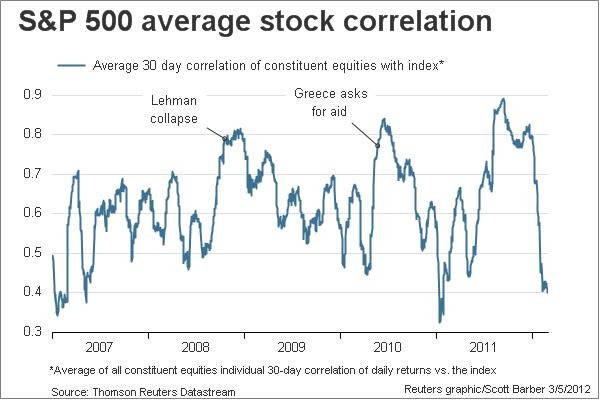By Michael Tarsala
Scott Barber at Reuters always comes up great insightful charts, and his latest may be saying something fairly positive about the health of the stock rally:

Scott’s latest chart shows the steepest drop in 5 years in the degree to which the S&P 500 index are moving with its underlying constituents.
As you might expect, periods of low average stock correlation suggest there is a wide variety of leading and lagging stocks. High average correlations, on the other hand, reflect a “group think” in the markets, where stocks tend to rise and fall together.
Here are some things I think the chart above may be saying to individual stock investors:
- There are risks, but also rewards for seeking outperformance: It may pay during times of low correlations to do your homework on individual stocks and sectors. Relative to high correlation periods, that is when you are more likely to find stocks and sectors that can outperform (or, of course underperform) the market as a whole.
- Long-short strategies may work better now: Group think tends to push returns toward zero during periods of high average stock correlation. However, low average stock correlations in theory can provide a long-short manager with a better opportunity to beat the market than a high correlation periods. Covestor has 18 different model managers that employ long-short strategies.
- It may be a reflection of lower perceived risk: A black swan event is always possible. But as Scott’s chart shows, 2008 and 2010 had rising correlations leading into negative market events. Group think can reflect fear on the part of professionals, and the desire to simply perform as well as the market. This can lead to self-fulfilling prophecies, and periods when most stocks tend to decline together.
- Arbitrageurs may not be working as hard against stockpickers: High-frequency traders make up the majority of equity volumes. Their returns tend to be best in volatile markets, where they can earn larger returns than they otherwise would on small market moves. One of the main games the high frequency crowd plays is index arbitrage. They will look for a group of stocks outperforming the index, sell those stocks and then buy the index. In a volatile market with the group-think in place, that strategy can be successful, and in theory can work against individual investors that are still seeking market outperformance. In lower volatility periods and when correlations are low, however, HFT traders are the ones that could be at a disadvantage.



